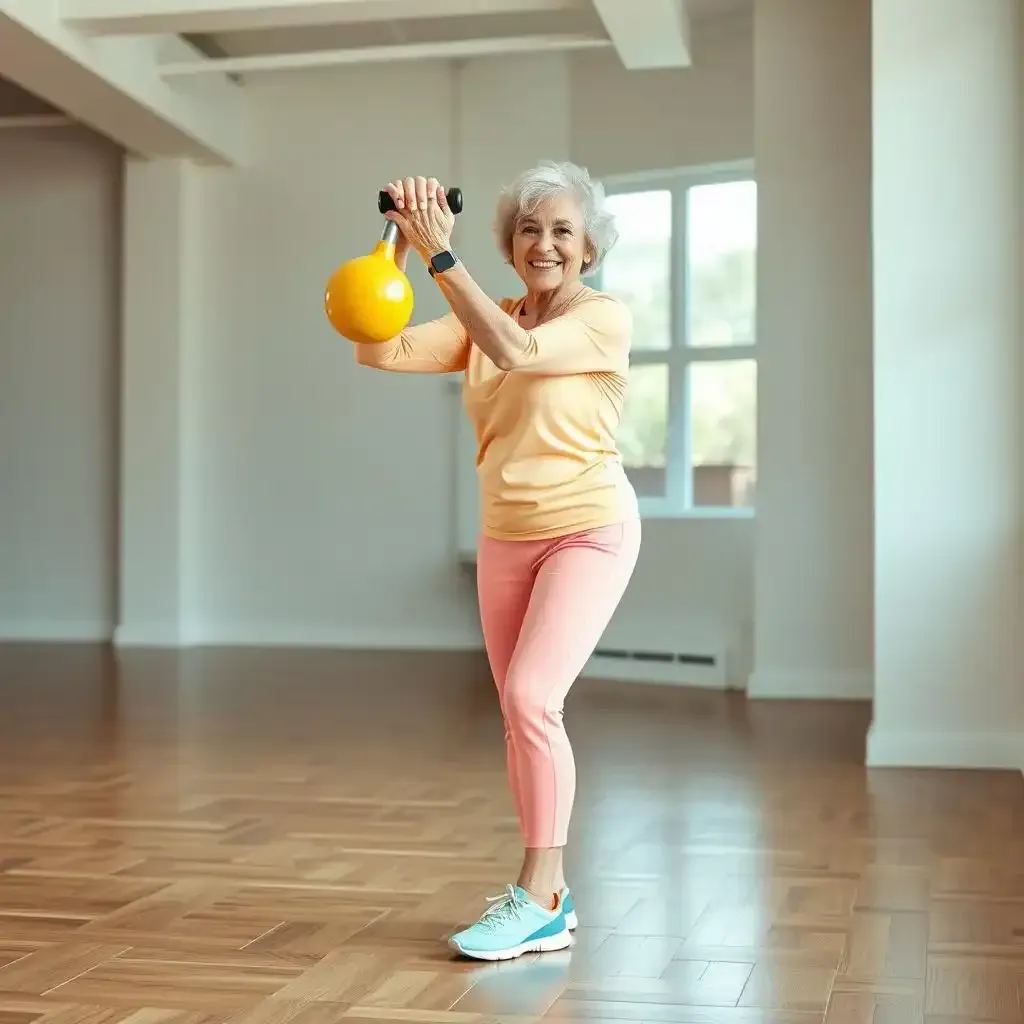Table of Contents
As we age, it's essential to prioritize our physical health to maintain independence, mobility, and overall well-being. Regular exercise is crucial, but it can be challenging to find activities that are enjoyable, effective, and safe for seniors. kettlebell exercises for seniors offer a fantastic solution, combining strength training, flexibility, balance, and cardiovascular fitness in a fun and engaging way. On kettlebellworkout.homes, we'll explore the benefits of kettlebell exercises for seniors, provide safety precautions and modifications, and outline effective workouts and routines to get you started. Whether you're a fitness enthusiast or just starting out, our guide will help you harness the capability of kettlebells to achieve your health goals.
1. Benefits of Kettlebell Exercises for Seniors
Improved Strength and Balance
Hey there, fellow fitness enthusiast! Let's talk about kettlebells for seniors – it's a game-changer. I've seen firsthand how these little weights can work wonders. Think of them as magic wands for your muscles. They don't just build strength; they help you stand straighter, walk steadier, and even get up from that comfy chair with more ease. It's like giving your body a superpower boost! My own grandma started using light kettlebells, and the difference in her stability is amazing. She's even more confident going down the stairs now!
Seriously, it's not just about lifting heavier things. Improved balance is key to staying independent as we age. Falls are a real concern for seniors, but strengthening those core muscles with kettlebell exercises directly combats that risk. It's like adding extra springs to your legs and a built-in gyroscope to your core. Kettlebell exercises are often described as a form of functional fitness, meaning the movements are designed to help you perform everyday actions more easily. Think about how often you need to lift, bend, and twist – kettlebells help you do those things with more strength and less strain. Check out some beginner routines on our site for some ideas!
Enhanced Cardiovascular Health and Flexibility
But wait, there's more! Kettlebell training isn't just about muscles; it's about getting your heart pumping, too! You'll find that many kettlebell exercises get your heart rate up, which is fantastic for cardiovascular health. It's a sneaky way to get your workout in without feeling like you're on a treadmill for hours. Think of it as a fun, dynamic cardio session disguised as strength training. You’ll be surprised how much of a sweat you can work up with some simple kettlebell swings.
And guess what else? Kettlebells aren't just about brute strength; they actually improve flexibility too! The various movements and stretches you can do with a kettlebell help to improve your range of motion. It's like giving your joints an oil change and a tune-up. This is especially important as we age, as flexibility helps prevent injuries and maintain ease of movement. You’ll feel more limber and less stiff. To learn more, check out our guide to simple kettlebell exercises. Remember, always listen to your body and don't push yourself too hard!
Benefit | Description |
|---|---|
Increased Strength | Improved ability to lift and carry objects |
Better Balance | Reduced risk of falls and improved stability |
Enhanced Cardio | Improved heart health and stamina |
Greater Flexibility | Increased range of motion and reduced stiffness |
2. Getting Started with Kettlebell Exercises for Seniors: Safety Precautions and Modifications

2 Getting Started With Kettlebell Exercises For Seniors Safety Precautions And Modifications
Consult a Healthcare Professional First
Before you grab that kettlebell, it's crucial to check in with your healthcare provider. They know your body better than anyone and can give you the green light to start your new fitness progression. Think of this step as getting a personalized map to guide you through the workouts. My uncle, for example, had a heart condition and his doctor recommended a few specific exercises that wouldn’t strain his heart too much. It’s always better to be safe than sorry, and a little advice can go a long way.
Once you have the okay, it’s time to pick the right kettlebell. Don't feel like you have to start with a heavy one. Lighter weights are perfect for beginners, and you can always work your way up. I recommend starting with a 8-10 pound kettlebell if you’re a woman, and a 12-15 pound one if you’re a man. You can find more on choosing the right weight . Remember, the goal is to build strength gradually and safely.
Step | Action | Tip |
|---|---|---|
1 | Consult a healthcare provider | Get personalized advice |
2 | Choose the right kettlebell | Start with lighter weights |
3 | Start with basic exercises | Focus on form over weight |
Focus on Proper Form and Technique
Form is everything when it comes to kettlebell exercises. Imagine you’re a beginner athlete learning a new sport. You wouldn’t start with complex moves, right? The same goes for kettlebells. Start with basic exercises and focus on mastering the form. This will not only prevent injuries but also make your workouts more effective. For example, the kettlebell swing is a fundamental move that can easily go wrong if you don’t do it right. Check out our for a step-by-step breakdown of the swing.
Another tip is to use a mirror or a workout buddy to check your form. It’s easy to lose track of your posture, especially when you’re focusing on the weight. A friend or a mirror can help you stay aligned and ensure you’re getting the most out of each exercise. My grandma uses a mirror to make sure her back is straight during her kettlebell workouts. She says it’s like having a personal trainer right there with her. It’s a simple trick, but it makes a big difference.
- Use a mirror to check your form
- Start with basic exercises
- Focus on form over weight
- Gradually increase the weight
3. Effective Kettlebell Exercises for Seniors: Workouts and Routines

3 Effective Kettlebell Exercises For Seniors Workouts And Routines
Okay, so you're ready to get swinging? Awesome! But let's not jump into anything too crazy. Think of starting a kettlebell routine like learning to ride a bike – you wouldn't start by attempting a wheelie, would you? You'd start with the basics, getting a feel for balance and coordination. Same goes for kettlebells. We're building a strong foundation here, not trying to become Olympic lifters overnight. For beginners, I highly recommend starting with simple routines, focusing on proper form more than the number of reps. Check out our guide to for some excellent starting points.
One of my favorite beginner exercises is the kettlebell swing. It's deceptively simple, but it works wonders for your core and your cardiovascular system. It’s like a secret weapon for building strength and improving your balance. It's all about the hip hinge – think of it as gracefully swinging a pendulum. Don't use your arms too much; let the ability come from your legs and core. Remember, we're building strength and coordination, not showing off our biceps! For more detailed instructions, check out our video guide to .
Exercise | Muscle Groups Worked | Notes |
|---|---|---|
Kettlebell Swing | Core, Glutes, Hamstrings | Focus on hip hinge |
Kettlebell Goblet Squat | Quads, Glutes, Core | Keep back straight |
Kettlebell Rows | Back, Biceps, Core | Maintain good posture |
Next up, let's talk about goblet squats. Hold the kettlebell close to your chest, like a precious goblet, and squat down. It’s a fantastic exercise for strengthening your legs and core. The key here is to keep your back straight and your chest up – imagine you're a proud penguin standing tall! It’s all about controlled movements and proper form. Don't rush it; feel the burn in your muscles. For a more detailed explanation on the goblet squat, check out our beginner kettlebell workout guide.
Finally, kettlebell rows are a great way to strengthen your back muscles. It’s like giving your back a superhero workout! Lean slightly forward, keeping your back straight (that penguin posture again!), and pull the kettlebell towards your chest. Squeeze those shoulder blades together, and feel the ability in your back. Remember to keep your core engaged throughout the movement. If you're unsure about your form, please consult our kettlebell form guide for detailed instructions and visual aids. This will help you avoid injuries.
- Start with lighter weights
- Focus on proper form
- Listen to your body
- Gradually increase reps and weight
Remember, consistency is key! Even short, regular workouts are more effective than infrequent, intense ones. Aim for 2-3 sessions per week to start, and gradually increase the frequency and intensity as you get stronger. Don't forget to warm up before each session and cool down afterward – your body will thank you for it! You can find some useful warm-up and cool-down routines in our warm-up guide and cool-down guide. Remember, it’s always better to be safe than sorry.
And remember, friends, this is a progression, not a race! Be patient with yourself, celebrate your progress, and most importantly, have fun! Kettlebell training can be challenging, but it's also incredibly rewarding. You’ll feel stronger, more balanced, and more confident in no time. For more advanced routines, check out our advanced routines page, but remember, only progress to this once you've mastered the basics.
"The greatest of follies is to sacrifice health for any other kind of happiness." - Arthur Schopenhauer
4. Overcoming Common Challenges in Kettlebell Exercises for Seniors

4 Overcoming Common Challenges In Kettlebell Exercises For Seniors
Dealing with Aches and Pains
Let's be real, folks. Getting older sometimes means dealing with aches and pains. It's not exactly a party, is it? But that doesn't mean you have to hang up your kettlebells! I've learned that listening to your body is key. If something hurts, STOP. Don't push through the pain; you're not a superhero (unless you consider gently rocking a kettlebell a superhero move – then, go for it!). It's better to take a break and modify the exercise than to risk injury. Sometimes, a tiny adjustment – like using a lighter kettlebell or changing your stance – can make all the difference.
Think of your body like a finely tuned instrument. You wouldn't force a rusty violin to play a concerto, would you? Similarly, you shouldn't push your body beyond its limits. If you're struggling with joint pain, for example, try focusing on exercises that don't put too much stress on those joints. There are plenty of modified exercises that still provide a great workout. Check out our guide to easy kettlebell exercises for some gentler options that are perfect for beginners and those managing injuries. Remember, progress is a marathon, not a sprint!
- Listen to your body
- Modify exercises as needed
- Don't push through pain
- Consider lighter weights
Staying Motivated and Consistent
Let’s face it, staying motivated can be a challenge, no matter your age. It's easy to get discouraged, especially when you're just starting out. But I promise you, the rewards of consistent kettlebell training are well worth the effort. One trick I've found helpful is to set small, achievable goals. Instead of aiming for a huge, overwhelming goal, start with something manageable, like doing three sets of ten kettlebell swings three times a week. Once you achieve that, you can gradually increase the number of sets, reps, or the weight of your kettlebell. This way, you'll celebrate your little victories along the way, and it keeps things fun and engaging.
Another tip is to find a workout buddy. Having someone to exercise with can make a huge difference in terms of motivation and accountability. Plus, it's more fun! My grandma works out with her friend, and they encourage each other every step of the way. They even celebrate their progress with a cup of tea and a chat afterward! Think of it as a social event disguised as a workout. If a workout buddy isn't an option, consider joining an online community or finding a fitness app that provides support and encouragement. Our website has a fantastic community forum where you can connect with other kettlebell enthusiasts and share your progress. For more tips on creating a sustainable routine, take a look at our kettlebell workout tips.
Challenge | Solution |
|---|---|
Lack of Motivation | Set small goals, find a workout buddy, join an online community |
Inconsistent Workouts | Create a schedule, set reminders, find an accountability partner |
Difficulty with Exercises | Modify exercises, start with easier variations, seek professional guidance |
Final Thought
Incorporating kettlebell exercises into your fitness routine can have a significant impact on your overall health and well-being as a senior. By following the guidelines, workouts, and safety precautions outlined in this article, you'll be well on your way to enjoying the many benefits of kettlebell training. Remember to always consult with a healthcare professional before starting any new exercise program, and don't hesitate to reach out if you have any questions or concerns. Happy training, and thank you for reading kettlebellworkout.homes!